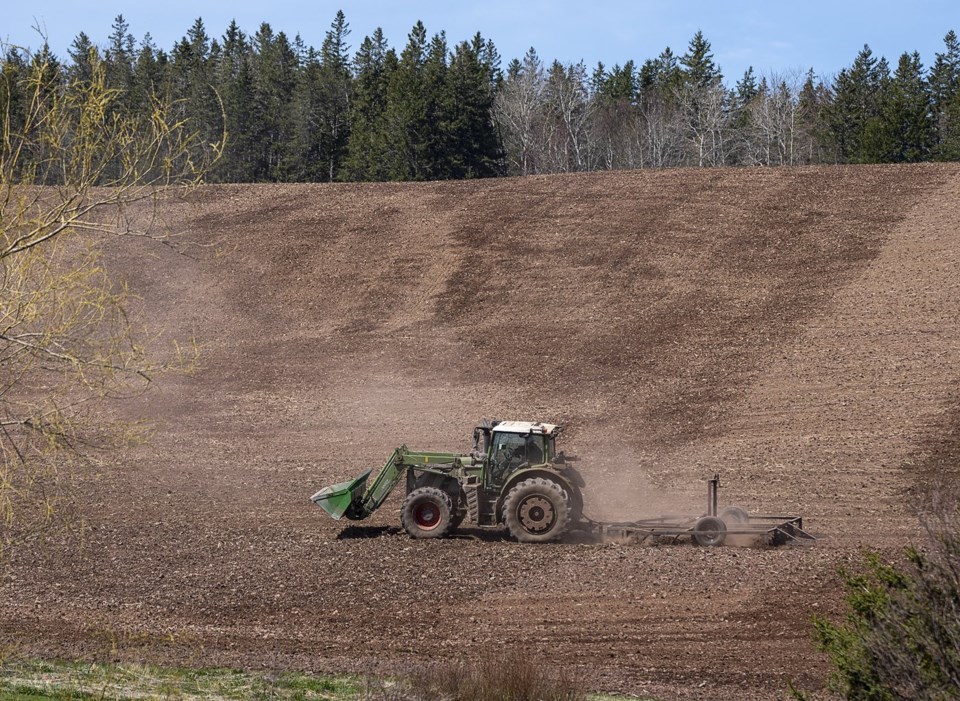HALIFAX — An East Coast drought that’s fuelling wildfires is also drying up farmers' fields, and has homeowners scrambling to refill empty wells.
Nova Scotia, eastern Newfoundland, southeastern New Brunswick and portions of Prince Edward Island shifted into moderate to severe drought conditions over the past month, says an Agriculture Canada update released Tuesday.
Rainfall has plummeted to roughly 60 per cent of normal levels in Halifax, with 270 millimetres falling from April to the end of July, compared to average levels of 460 mm for the same period, the federal agency says. In Newfoundland and Labrador, where wildfire smoke is swirling within sight of the capital St. John's, rainfall over the same period is down about one-third from normal levels.
"It looks to be one of the driest Augusts on record (to date) … preceded by one of the driest months of July to date," Environment Canada forecaster Brian Proctor said in a recent interview.
Trevor Hadwen, a specialist with Agriculture Canada, said that while the drought conditions aren't unprecedented in the Atlantic region, 2025 has been an "abnormally dry" year.
"The drought in some regions has come on strong and we're seeing some pretty severe impacts from the drought, such as water supply losses and shortages and drying up of surface water supplies," he said Monday.
Farmers in Nova Scotia are describing the water shortages as the most severe in recent memory.
Jordan Eyamie, the manager of Webster Farms Ltd. in Cambridge, N.S., says she and her field staff are fatigued from 12-hour days spent hauling irrigation gear onto strawberry, raspberry, bean and rhubarb fields.
The beans aren't growing to normal size, while it's a struggle to keep the berries and rhubarb from withering, she said in a recent interview. Some wells are drained to the point where she wonders if they'll last through the summer.
"Our yields are certainly going to be down … and everyone is exhausted trying to keep the irrigation systems going due to the lack of rain, and it doesn't seem like there's any hope in sight."
Proctor said the forecast calls for only light precipitation in the region by Friday, adding, "at this point it's probably best to anticipate continuing warm and dry conditions across Atlantic Canada."
As of Tuesday morning, five of Newfoundland and Labrador’s active wildfires were considered out of control, while two out-of-control fires were burning In New Brunswick. Both New Brunswick and Nova Scotia have banned activities like hiking and fishing in forested areas.
Josh Oulton, co-owner of TapRoot Farms in Windsor, N.S., said in a recent interview that water is being pumped from his wells to irrigate crops but the "apples are suffering badly." The beets and carrots he planted earlier in the summer aren't growing.
"Everything is just barely holding on. At the same time the prices from suppliers are going up … and we're slowly dying," he said.
As the hot, dry days continue, some rural residents are scrambling to ensure their wells are kept full. In Nova Scotia, about 42 per cent of residents are on private well water.
Garth Higgins, owner of Water Unlimited — a water delivery firm in eastern Nova Scotia — said he's seeing the highest demand for his services since he began operating 19 years ago.
The 54-year-old resident of Cooks Brook, N.S., recalls that there was a dry season late in the summer in 2016, but it wasn't as severe. When reached on Monday morning, he had a list of 33 deliveries booked and orders coming in every few minutes.
"There are people calling me daily, saying my well just ran out — it just ran out," he said in an interview. "It means no running water in the house. No baths, no showers, no flushing toilets."
Higgins said the shortages are mostly happening in smaller communities, which aren't able to access the reservoirs serving cities.
The Halifax Regional Municipality has voluntary water conservation measures in effect, but many smaller, rural towns in northern Nova Scotia and the Annapolis Valley have brought in mandatory limits as their reservoirs run low.
Jennifer MacNeil, a spokeswoman for New Brunswick's Environment Department, said stream flows at sites in the northeast, southeast and along the Fundy Coast are at "all time lows." Groundwater levels at eastern and southeastern monitoring sites "are well below normal."
"With no significant precipitation in the near-term forecast, water resource conditions are expected to continue to gradually decline. A slow and steady rainfall over several days is needed to improve water levels," said MacNeil.
Gordon Check, a hydrogeologist with Nova Scotia's Environment Department, said in an interview Monday there is a cycle in groundwater, where levels rise in autumn and winter but drop in summer. However, he said that this summer the levels have fallen to their lowest annual point earlier than usual.
"Where last year the lows may have occurred more towards August and September, this year they're about a month earlier," he said.
This report by The Canadian Press was first published Aug. 12, 2025.
Michael Tutton, The Canadian Press



